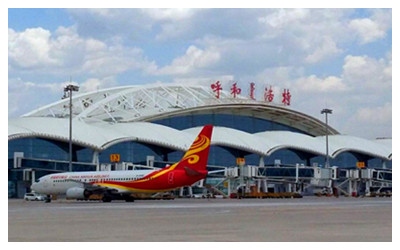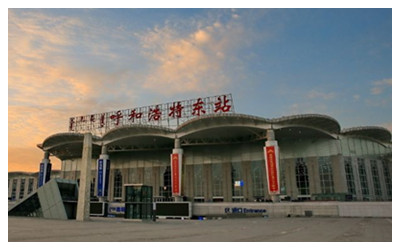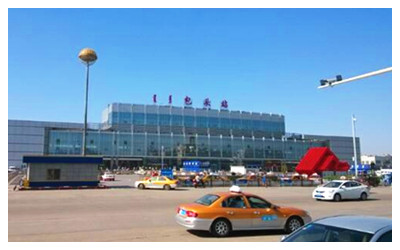- Home
- Province Guide > Inner Mongol >
Inner Mongolia Transportation
After 70 years of development, Inner Mongolia transportation has been improved greatly, whose comprehensive coverage ability and service level of air, train, and bus have stepped forward, so it is very easy to reach any city by train, bus or plane if you want to travel Inner Mongolia.
By Air

There are 9 airports in Inner Mongolia. They are Huhehaote Airport, Baotou Airport, Hailaer Airport, Xilinhaote Airport, Chifeng Airport, Tongliao Airport, Wulanhaote Airport, Manzhouli Airport, and Wuhai Airport. In these nine airports, airplanes fly to all the big cities in China as well as the capital of Mongol, the capital of Thailand and some other cities. The airline net in Inner Mongolia is quite mature now.
By 2020, Inner Mongolia air group has operated 191 air lines (8 international lines, and 1 region line). The cities that open to air traffic are 55, and there are 24 airlines.
By Train

Nowadays, there are 19 national main railways, 12 branches and 5 local railways in Inner Mongolia. These railways lead to
Beijing, Xi’an, Hailaer, Lanzhou, Yinchuan and other big cities. Up to now, the total length of railway in Inner Mongolia reaches to 3120 kilometers. And the main railways like Jingbao Railway, Baolan Railway, Binzhou Railway, Jitong Railway, Jingtong Railway, Jier Railway connect China and Russia and Mongol together.
The railway lines in Inner Mongolia have governed by three railway bureaus under Ministry of Railways.
1. Haribin Railway Bureau
Administrative parts: All areas in Hulun Buir city
Department: Harbin Railway Bureau Hailar Railway Office
Rail tracks: 2 trunk lines—Binzhou line (Harbin to Manzhouli), Yalin line (Yakeshi to Mangui)
7 branch lines—Bolin line (Boketu to Taerqi), Yijia line (Yitulihe to Jiagedaqi), Yimin line (Hailar east to Yimin ), Chaowu line (Chaozhong to Moerdaoga), Yi’a line (Yimin to Ilxie ), Azha line (A Rong Banner to Zhalantun).
2. Shenyang Railway Bureau
Administrative parts: all areas in Xing’an League, Tongliao city, Chifeng city
Department: Shengyang Railway Bureau Tongliao Railway Office
Rail tracks: 4 trunk lines—Pingqi line (Siping to Tsitsihar), Jingtong line (
Beijing north to Tongliao west), Tonghuo line (Tongliao north to Holingol), Dazheng linge (Dahushan Island to Zhengjiatun).
6 branch lines: Tongrang line (Tongliao east to Ranghu road), Yechi line (Yeboshou to Chifeng), Chijin line (Chifeng to Jinzhou), Chidabai line (Chifeng-Daban-Baiyinhua), Zhuzhu line (Zhusihua to Hesigewula), Huobai line (Holingol to Baiyinhua)
3. Hohhot Railway Bureau
Administrative parts: middle and west of Inner Mongolia like Hohhot, Baotou, Wuhai, Ordos, Bayannur, Ulanqab, Alxa, Xilingol, Chifeng north.
Rail tracks: 7 trunk lines—Jingbao line (Beijing north to Baotou), Baolan line (Baotou west to Lanzhou east), Ji’er line (Jining to Erenhot), Jitong line (Jining to Tongliao north), Baoxi line (Baotou to
Xian), Jizhang line (Jining south to Zhangjiakou south), Jibao line (Jining south to Baotou)
8 branch lines (including one loop line)—Baobai line, Baoshi line, Baohuan line, Wuji line, Haigong line, Guocha line, Baoshen line, Lince line
1 high-speed train line (under construction, up to 2012)—Zhanghu Passenger Railway line, Hu-Zhun-E line (Hohhot-Jungar- Ordos)
By Bus

As of December 16, 2011, Inner
Mongolia highway total mileage of 157000 kilometers. In the beginning of the Inner
Mongolia autonomous region was established in 1947, there was only nearly thousand kilometers of ancient post road for camels and lele cart. 64 years later, a road network was initial shaping that cut-through Russia and Mongolia and link up north and south, east and west. During “the Twelfth Five-Year" project, the country would focus on supporting the construction of highway in Inner Mongolia and establishing Inner Mongolia integrated transport system construction conducive to the development of comprehensive transport hub. By 2015, Inner Mongolia highway mileage would reach 170000 km.

 Nowadays, there are 19 national main railways, 12 branches and 5 local railways in Inner Mongolia. These railways lead to Beijing, Xi’an, Hailaer, Lanzhou, Yinchuan and other big cities. Up to now, the total length of railway in Inner Mongolia reaches to 3120 kilometers. And the main railways like Jingbao Railway, Baolan Railway, Binzhou Railway, Jitong Railway, Jingtong Railway, Jier Railway connect China and Russia and Mongol together.
Nowadays, there are 19 national main railways, 12 branches and 5 local railways in Inner Mongolia. These railways lead to Beijing, Xi’an, Hailaer, Lanzhou, Yinchuan and other big cities. Up to now, the total length of railway in Inner Mongolia reaches to 3120 kilometers. And the main railways like Jingbao Railway, Baolan Railway, Binzhou Railway, Jitong Railway, Jingtong Railway, Jier Railway connect China and Russia and Mongol together. As of December 16, 2011, Inner Mongolia highway total mileage of 157000 kilometers. In the beginning of the Inner Mongolia autonomous region was established in 1947, there was only nearly thousand kilometers of ancient post road for camels and lele cart. 64 years later, a road network was initial shaping that cut-through Russia and Mongolia and link up north and south, east and west. During “the Twelfth Five-Year" project, the country would focus on supporting the construction of highway in Inner Mongolia and establishing Inner Mongolia integrated transport system construction conducive to the development of comprehensive transport hub. By 2015, Inner Mongolia highway mileage would reach 170000 km.
As of December 16, 2011, Inner Mongolia highway total mileage of 157000 kilometers. In the beginning of the Inner Mongolia autonomous region was established in 1947, there was only nearly thousand kilometers of ancient post road for camels and lele cart. 64 years later, a road network was initial shaping that cut-through Russia and Mongolia and link up north and south, east and west. During “the Twelfth Five-Year" project, the country would focus on supporting the construction of highway in Inner Mongolia and establishing Inner Mongolia integrated transport system construction conducive to the development of comprehensive transport hub. By 2015, Inner Mongolia highway mileage would reach 170000 km. Ask Questions ?
Ask Questions ?